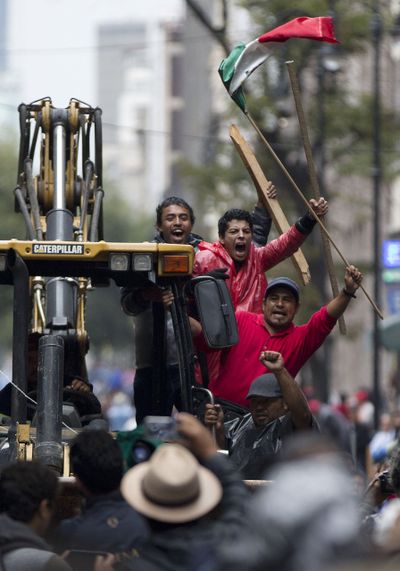Teachers cleared from historic Mexico square
Mexico City center occupied for several weeks

MEXICO CITY – Launching a full-court press to clear Mexico City’s historic Zocalo square of striking teachers, riot police battled protesters in rolling street skirmishes Friday as the two sides exchanged tear gas canisters and Molotov cocktails.
By late afternoon, the Zocalo was rid of the thousands of teachers who had been camped out there for weeks. But the vast plaza was a trash-strewn mess, drenched and covered in crushed plastic tenting.
Government patience with the protesting teachers finally faded Friday on the eve of Independence Day celebrations scheduled for this weekend. The Zocalo is the centerpiece of Mexico’s most symbolic day of patriotism: The president of the republic traditionally appears on the balcony of the National Palace overlooking the Zocalo to re-enact the midnight “grito,” or call to arms, that launched the struggle for Mexican independence from Spain 203 years ago.
If President Enrique Pena Nieto had not been able to deliver his first grito in proper fashion on Sunday night, it would have been terribly embarrassing.
Several people were reported injured or detained after Friday’s clashes, including a number of union members.
Following days of furious negotiations, most teachers from the feisty National Coordinator of Education Workers, or CNTE, had agreed to temporarily abandon the Zocalo and head to other sites like nearby Plaza of the Revolution.
But a small, particularly tenacious faction from southern Oaxaca state stayed behind, at least at first.
Legions of federal police with plastic shields, helmets and batons pushed through the Zocalo, driving out the remaining teachers and their supporters. In the ensuing hours, more skirmishes broke out on side streets of downtown Mexico City.
As is often the case in these kinds of demonstrations, there were elements – masked youths tearing apart chunks of pavement and hurling those along with Molotov cocktails at police – who probably were not teachers at all. The self-described anarchists often latch on to other causes to stoke the flames of social unrest.
The teachers, meanwhile, remained defiant, saying they would return to the Zocalo after independence festivities. They have repeatedly tied this capital, one of the world’s largest cities, in knots, blocking major roadways, access to the international airport and key government buildings like Congress.
Their principal grievance is Pena Nieto’s wide-ranging reform of Mexico’s abysmal education system, an overhaul designed to weaken the power of unions, require evaluations of teachers’ performances and end the practice of selling or bequeathing teaching positions to people without skills.
The teachers – primarily from Mexico’s poorest and poorest-performing educational systems in Oaxaca, Michoacan and Guerrero states – resist evaluations that don’t consider their cultural differences. They also argue that reform ought to focus on spending more money on impoverished schools.
But in the midst of the teachers’ protests, the president’s education reform cleared all of its legislative hurdles and is now the law of the land.